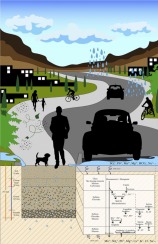当前位置:
X-MOL 学术
›
J. Hazard. Mater.
›
论文详情
Our official English website, www.x-mol.net, welcomes your feedback! (Note: you will need to create a separate account there.)
Mineralogical evidence of unfavorable geochemical interactions between urban runoff pollutants and filter materials in low-impact systems.
Journal of Hazardous Materials ( IF 13.6 ) Pub Date : 2020-01-18 , DOI: 10.1016/j.jhazmat.2020.122136 Marcelino Antonio Zúñiga-Estrada 1 , Gabriela A Vázquez-Rodríguez 1 , Màrius Ramírez-Cardona 2 , Liliana Lizárraga-Mendiola 3
Journal of Hazardous Materials ( IF 13.6 ) Pub Date : 2020-01-18 , DOI: 10.1016/j.jhazmat.2020.122136 Marcelino Antonio Zúñiga-Estrada 1 , Gabriela A Vázquez-Rodríguez 1 , Màrius Ramírez-Cardona 2 , Liliana Lizárraga-Mendiola 3
Affiliation

|
We report on the geochemical interactions between a synthetic urban runoff (SUR) and the minerals of materials used in a multi-layered column filter (soil, sand, gravel, and tezontle) at the laboratory scale, which mimicked an unvegetated low-impact development (LID) system. After five 8 h infiltration cycles using the SUR, the average concentrations of Pb and Mn decreased slightly at the column outlet, as did HCO3-, SO42-, and Na+, whereas Mg increased and Cl-, Ca2+, and K+ were only detected at the outlet. The filter materials were comprised of silicates, Mn-bearing oxides (hausmannite and manganite), carbonates (calcite), chlorides (sylvite), and sulfates (anglesite, lanarkite, barite, and epsomite). PHREEQC modeling allowed the identification of the geochemical processes that occurred in the filter. The results showed the removal capacity of the filter materials through the formation of secondary minerals such as rhodochrosite (MnCO3) and the over-saturation of anglesite (PbSO4), and also showed that they may mobilize ions from the upper to the interior layers (as Mg2+ from epsomite, MgSO4·7H2O, and Ba2+ from barite, BaSO4). We highlight the importance of knowing the geological nature of filter materials used in LID systems because they may lead to the geogenic mobilization of toxic contaminants to the environment.
中文翻译:

低冲击系统中城市径流污染物与过滤材料之间不利的地球化学相互作用的矿物学证据。
我们报告了实验室规模的合成城市径流(SUR)与多层柱过滤器(土壤,沙子,砾石和tezontle)中使用的材料的矿物之间的地球化学相互作用,该现象模拟了无植被的低影响开发(LID)系统。在使用SUR进行5个8小时的渗透循环后,塔出口的Pb和Mn的平均浓度略有降低,HCO3-,SO42-和Na +的浓度也有所降低,而Mg的增加以及Cl-,Ca2 +和K +的检测仅在出口。过滤材料由硅酸盐,含锰氧化物(菱锰矿和锰矿),碳酸盐(方解石),氯化物(钾盐)和硫酸盐(角铁,镧铁矿,重晶石和泻石)组成。PHREEQC建模可以识别过滤器中发生的地球化学过程。结果表明,滤料通过形成二级矿物如菱锰矿(MnCO3)和过饱和角钢(PbSO4)的去除能力,还表明它们可以将离子从上层迁移到内层(如泻岩中的Mg2 +(MgSO4·7H2O)和重晶石中的Ba2 +(BaSO4)。我们强调了解LID系统中使用的过滤材料的地质性质的重要性,因为它们可能导致有毒污染物向环境中迁移。
更新日期:2020-01-21
中文翻译:

低冲击系统中城市径流污染物与过滤材料之间不利的地球化学相互作用的矿物学证据。
我们报告了实验室规模的合成城市径流(SUR)与多层柱过滤器(土壤,沙子,砾石和tezontle)中使用的材料的矿物之间的地球化学相互作用,该现象模拟了无植被的低影响开发(LID)系统。在使用SUR进行5个8小时的渗透循环后,塔出口的Pb和Mn的平均浓度略有降低,HCO3-,SO42-和Na +的浓度也有所降低,而Mg的增加以及Cl-,Ca2 +和K +的检测仅在出口。过滤材料由硅酸盐,含锰氧化物(菱锰矿和锰矿),碳酸盐(方解石),氯化物(钾盐)和硫酸盐(角铁,镧铁矿,重晶石和泻石)组成。PHREEQC建模可以识别过滤器中发生的地球化学过程。结果表明,滤料通过形成二级矿物如菱锰矿(MnCO3)和过饱和角钢(PbSO4)的去除能力,还表明它们可以将离子从上层迁移到内层(如泻岩中的Mg2 +(MgSO4·7H2O)和重晶石中的Ba2 +(BaSO4)。我们强调了解LID系统中使用的过滤材料的地质性质的重要性,因为它们可能导致有毒污染物向环境中迁移。



























 京公网安备 11010802027423号
京公网安备 11010802027423号